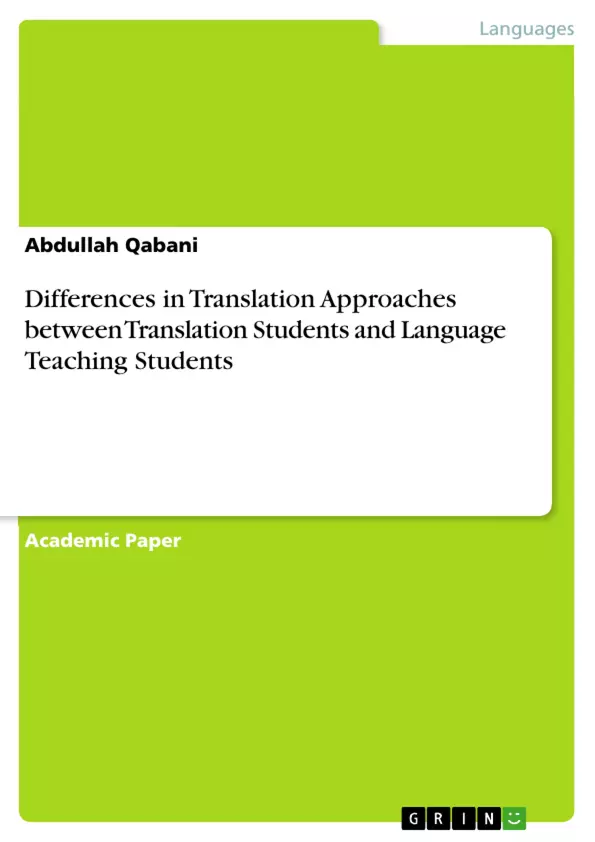This paper investigates the differences in translation approach between translation students and language teaching students. In particular, it discusses differences in the way each group approaches translation and the effect of those approaches on the translation or the final product. Two groups of students attending King Saud University in Saudi Arabia, one the faculty of Languages and Translation and the other the Faculty of Education, participated in the study, which applied qualitative and quantitative methods to answer the research questions.
The findings concluded that there are differences in the way each group approaches translation. However, the observed approaches and patterns are not distinctive; they are shared by both groups in varying intensity. Attributing those differences in approaches to educational background requires further investigation.
Inhaltsverzeichnis (Table of Contents)
- Abstract
- Introduction
- Main Questions and hypothesis
- Data and methodology
- Literature Review
- Systemic Functional Linguistics and Translation
- Language teaching education
- Translation Education
- Comparison of Language and Translation Education
- Similarities
- Differences
- Discussion of issues for both groups
- Minor (a)
- Idiomatic expression (b)
- Addition (c)
- Omission (d)
- Distinctive translation patterns and features
- Pattern 1
- Pattern 2
- Pattern 3
- Pattern 4
- Pattern 5
- Pattern 6
- Pattern 7
- Pattern 8
- Pattern 9
Zielsetzung und Themenschwerpunkte (Objectives and Key Themes)
This research aims to explore the discrepancies in translation approaches between students pursuing translation studies and those enrolled in language teaching programs. The study investigates the impact of these distinct approaches on the final translated product. Through the analysis of translations by students from the King Saud University in Saudi Arabia, the study seeks to identify whether formal training in translation studies results in noticeable differences in translation strategies and whether these differences significantly affect the conveyance of meaning.
- Differences in translation approaches between translation and language teaching students.
- The influence of educational background on translation strategies.
- The impact of translation approaches on the accuracy and clarity of the translated text.
- The role of systemic functional linguistics (SFL) in analyzing translation differences.
- The application of qualitative and quantitative methods in evaluating translation approaches.
Zusammenfassung der Kapitel (Chapter Summaries)
The study begins by introducing the context of translation and its importance in multilingual and multicultural societies like Saudi Arabia, particularly highlighting the lack of formal standards in translator recruitment. This leads to the central research question: Are there differences in translation approaches between formally trained translators and those without formal training?
The research methodology is then detailed, outlining the data collection process and the use of both quantitative and qualitative methods. The study focuses on analyzing translations by students from two disciplines: translation studies and language teaching. This chapter also outlines the chosen source text, "Mark Rothko 1903-1970," and its potential challenges for translators.
Chapter 3 dives into the theoretical framework of systemic functional linguistics (SFL) and its relevance to translation studies. SFL emphasizes the social and functional aspects of language, viewing it as a system of choices made by speakers and writers to convey meaning. The chapter explores how SFL can be applied to understand the differences in translation approaches between students from different educational backgrounds.
In Chapter 4, the research examines the specific nature of language teaching education, highlighting its focus on developing fluency and understanding of a second language. The chapter discusses various approaches and methods used in language teaching, emphasizing the distinction between approach, method, and technique.
Chapter 5 delves into the specific field of translation education. It outlines the core goals of translation education, such as fostering an understanding of translation theory, developing fluency in the target language, and instilling the importance of lifelong learning. This chapter also highlights the significance of biculturalism in translation, emphasizing the need for translators to understand the cultural context of the source text.
Chapter 6 compares and contrasts language teaching and translation education. While acknowledging similarities such as the types of schools offering these programs and the common goal of developing language proficiency, the chapter emphasizes the crucial differences in their scope and objectives. Translation education, unlike language teaching, requires a deeper understanding of the translation profession and the cultural nuances involved in accurate translation.
Finally, Chapter 7 delves into a discussion of specific translation issues that arise in the study, analyzing different categories of errors and patterns observed in student translations. This chapter provides a detailed analysis of the translation differences between the two groups and offers preliminary observations about the potential impact of educational background on translation approaches.
Schlüsselwörter (Keywords)
The study focuses on the intersection of translation approaches, systemic functional linguistics (SFL), translator education, language teaching education, and the analysis of translation patterns. The core concepts explored include the influence of educational background on translation strategies, the accuracy and clarity of translated texts, and the application of quantitative and qualitative methods in evaluating translation approaches. The research investigates the practical implications of these themes, drawing upon real-world examples of translation practices within the context of Saudi Arabia.
- Citar trabajo
- Abdullah Qabani (Autor), 2011, Differences in Translation Approaches between Translation Students and Language Teaching Students, Múnich, GRIN Verlag, https://www.grin.com/document/500623



